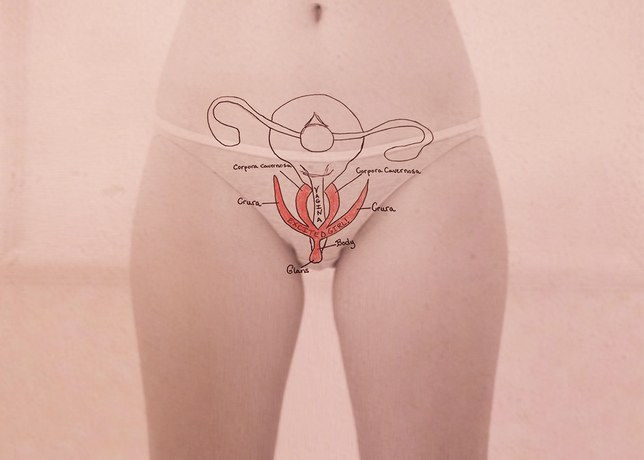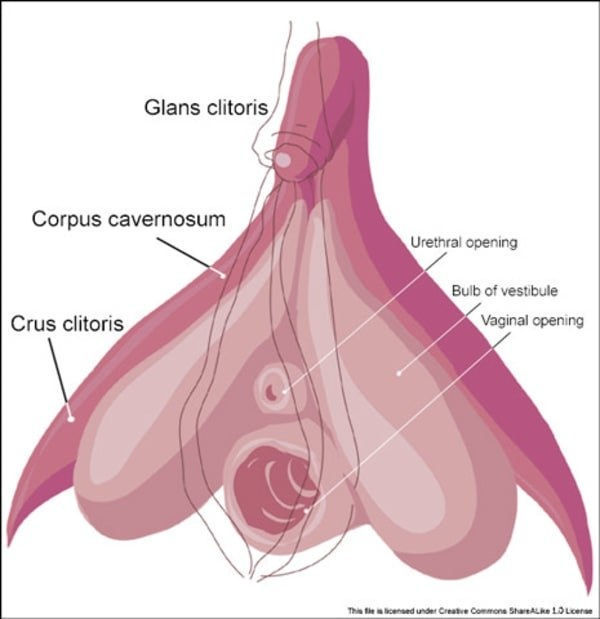There’s a Secret Part to Your Clitoris You Didn’t Know Existed

It’s surprising that, even in 2017, there’s still so much about women’s anatomy that we’re not talking about. For example, most of us probably don’t know that there’s more to our clitoris than that little rosebud-shaped knob at the apex of our labia. But in reality that little love button is only the tip of a surprisingly complex iceberg called the internal clitoris.
The internal clitoris was the hot topic at a recent Future of Sex live panel, a gathering of the sex industry’s most brilliant minds to discuss sexuality, vaginas, and women’s pleasure. Those minds included Alex Fine, cofounder of Dame Products, Polly Rodriguez, founder of Unbound, and Mal Harrison, director of the Center for Erotic Intelligence (formerly Ms. M, advice giver over at the Museum of Sex’s website). These women are basically the experts on everything clit science—and yes, clit science is totally a thing.
So what are all the things the mysterious internal clitoris do? Here’s some of the most important stuff to know about this amazing organ:
The internal clitoris is way bigger than you’d think.
Let’s get biological! The clitoris as a whole is composed of an external circular mass of glans, with bulbous internal extensions (called the vestibular bulbs) and internal winglike extensions (called the corpus cavernosum).
In a sonogram picture it looks a bit like an eagle in flight, descending upon its prey. “The clitoris continues on inside of the body, allowing for clitoral stimulation via the vaginal wall and other parts of the vulva,” Alex Fine explained. The external part of the clitoris is probably the part you’re most familiar with (and if you’re not, you better go find it ASAP).
The clitoris contains more than 8,000 nerve endings, and is made up of the same erectile tissue as the penis—it even fills with blood and becomes engorged when we’re aroused, just like a how a dude’s junk does. In a lot of ways, it really is the female equivalent of the penis, but we don’t need to call it that because women deserve control and agency over their bodies.
But it’s not just the part of the clit we can see that reacts when you’re aroused. According to Rebecca Brightman, M.D., an ob-gyn at East Side Women’s Associates, the entire clitoris is “0.5 to 2 cm in length, and the glans is less than 1 cm. The entire clitoral complex—including the internal wings—will become engorged and enlarged with stimulation.”

Not a lot was understood about the clitoris until surprisingly recently.
Most of our info about the clit comes from research done in the nineties. No, not the 1890s: The medical community was still largely uninterested in female pleasure until 20 years ago.
Harrison tells Glamour that the medical community didn’t know about the clitoris’ identical makeup to the penis until—surprise, surprise—a female urologist named Helen O’Connell, M.D., figured it out while dissecting cadavers. She published her work, “The Anatomy of the Clitoris,” in 1998.
Though most women probably knew that their lady bits were a source of pleasure long before science caught up, doctors and scientists believed the clit was a rather straightforward piece of anatomy. The assumption was that the clitoris was comprised entirely of a small exterior bundle, with nothing to see below. It wasn’t until MRAs were done of the clitoris that its deeper, internal structure was finally revealed. Not only that, but “the first 3-D sonography of the clitoris happened in 2008,” says Fine. Scientists Buisson and Foldès were two of the leading researchers in uncovering its full structure, using sonograms to document its movement, sensitivity, and what it looked like.
All orgasms are technically clitoral orgasms.
Yup, even G-spot orgasms (the G-spot is actually the spot closest to the root of the clit).
Of course, there’s much more to the female orgasm than the clitoris, or even the vagina for that matter. Female pleasure is derived from a variety of pleasure points; clusters of muscles and nerves on various erogenous zones, such as the nipples, ears, and thighs. Women’s bodies are complex, with a vast number of pleasurable pathways to explore.
Still, the clitoris may exist for more than just sexy times. The clitoris, says Dr. Brightman, “plays a role in sexual response: During ovulation women have an increased sex drive and libido. Positive sexual experiences foster procreation. So, indirectly, the clitoris plays another role than just pleasure.” After all, if we don’t enjoy sex, how can we be expected to have it and make babies?
When it comes to women’s bodies, it’s safe to say the clit is queen—even if there’s still probably a lot more to know about the clitoris, pleasure, and sexuality as a whole.

